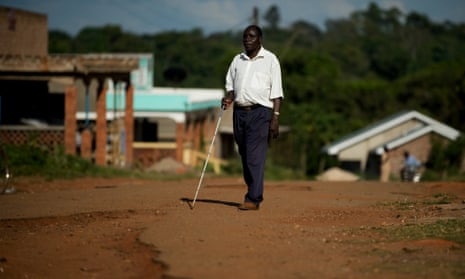You have been working on a new global mapping project. Before we get to that, can you explain what exactly blinding trachoma is?
Trachoma is the world’s most common infectious cause of blindness. It currently affects 21m people and a further 180m are at risk. It is a bacterial infection that causes a chronic conjunctivitis known as ‘active’ trachoma which irritates the eyes. Each episode of the infection causes scarring on the inside of the eyelid. In some people, this scarring eventually makes the edge of the eyelids turn inwards. This is known as trichiasis, and it currently affects an estimated 7.3m people.
Where is it most common?
Infection is most common in children. This in turn means women are much more susceptible to the blinding consequences of trachoma than men. Women, generally speaking, tend to provide childcare and so are exposed to more episodes of infection over their lifetime. It is spread through the discharge from an infected child’s eyes and passed on by hands, on clothing, or by flies that land on the face of an infected child.
People in crowded households or neighbourhoods are particularly vulnerable. The disease is also linked to extreme poverty and poor access to water and sanitation.
What are the wider consequences of trachoma?
People who are blind from trachoma have considerably reduced education and employment prospects and are often socially isolated or even ostracised. In addition, family members may be responsible for their care, removing not one but two individuals from education or employment. So like other neglected tropical diseases, trachoma is not only caused by poverty, it promotes poverty, setting up a vicious cycle.
Tell us about the trachoma project and what makes it the “largest disease mapping project ever attempted”?
The Global Trachoma Mapping Project (GTMP), is working to examine a sample of 4m people across 30 countries. Prior to the project it was known that over 110m people lived in confirmed trachoma-endemic areas in some of the world’s poorest countries. However, we knew another 210m people lived in areas where insufficient data had been gathered and where there were strong indications that trachoma was present. This was why there was a need to complete the mapping.
To our knowledge, the number of people examined by this project is greater than any disease mapping project previously attempted. We are currently engaged in mapping, or have completed mapping, in 20 countries, but are still in the planning stages of several others.
How is the project using mobile technology?
The basic premise is that survey teams visit communities and capture data on the presence of the disease using a mobile.
However with such a large scale project such as GTMP, we needed to use cloud technology to store database and manage the information. And so the system Links was created. With Links, teams around the world are able to collect data on water and sanitation, household and individual characteristics, and disease prevalence and submit their results over mobile to a central system. From there it can be reviewed by authorised individuals from any internet device.
Importantly this design provides a platform which is respectful of national data ownership and security by enabling the ministry of health in a given country to quickly review, approve, or query data as it is collected.
What are the challenges and limitations in using this technology?
The main challenges have been encouraging the acceptance of the technology and the ability to use it in very remote areas. However, the acceptance of systems such as Links has been growing as national programmes become more familiar with these technologies. Additionally, remote mobile coverage is improving. Where we do not have coverage data is stored on the phones until a mobile or Wi-Fi network is in range.
How do you see the data being used by other health professionals?
The data collected by mapping is helping health ministries mostly in Africa and Asia, to plan their trachoma programmes in line with the WHO-recommended interventions that make up their Safe strategy.
The data gathered so far is already helping to guide requests for the antibiotic Zithromax, to help health workers plan for surgeries, and establish approaches for improvements in access to water, sanitation and hygiene.
The WHO wants the disease eliminated by 2020. Once the mapping is completed, what will it take to reach this target?
Completing the mapping is a massive job, but it is a small part of the overall body of work that needs to be completed in order to eliminate trachoma as a public health problem by 2020. However, the advantage of completing the global map is that it will focus the minds of all those working on the issue on exactly where we need to do what, and when, to give us a chance of achieving that goal.
Alex Pavluck works for the International Trachoma Initiative and supported the development of the technology for this project.
Read more stories like this:
How do we solve a problem like trachoma?
How to … use maps to raise awareness
Technology: using power for good
Join our community of development professionals and humanitarians. Follow @GuardianGDP on Twitter.

Comments (…)
Sign in or create your Guardian account to join the discussion